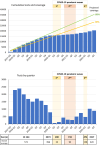Transition from opportunistic cytological to organized screening program with DNA-HPV testing detected prevalent cervical cancers 10 years in advance
- PMID: 39237756
- PMCID: PMC11377760
- DOI: 10.1038/s41598-024-71735-2
Transition from opportunistic cytological to organized screening program with DNA-HPV testing detected prevalent cervical cancers 10 years in advance
Abstract
Cervical cancer screening in Brazil is opportunistic, based on cytology and offered for women aged 25-64 years, with low coverage (30%) and 70% of cancer diagnoses done in advanced stages, without impact on mortality. The current study reports 5-year first-round results of a population-based DNA-HPV testing screening program in a Brazilian city, which intended to be a model for transition to a more efficient program. Program flowchart is simple and current, indicating repetition of a negative test after five years. The first-round (October 2017-September 2022) screened 20,551 women by DNA-HPV testing with 58.7% coverage and 99.4% compliance with the program's targeted age range. Coverage increases to 77.8% when excluding the 'pandemic period'. The DNA-HPV testing was 87.2% negative with 6.2% colposcopy referrals and 84.8% colposcopies performed. A total of 258 high-grade precursor lesions and 29 cervical cancers (mean age = 41.4 years, 83% Stage I) were detected. As a reference, 41,387 cytology tests from the previous program (2012-2016) detected 36 cervical cancers (mean age = 52.0 years, p = 0.0005), with 67% in advanced stages (p < 0.0001). Organizing cervical cancer screening using DNA-HPV testing demonstrated good coverage, high age and colposcopy compliance, and detection of more precancerous lesions and cervical cancers 10 years in advance.
© 2024. The Author(s).
Conflict of interest statement
The authors declare no competing interests.
Figures

References
-
- Estimate/2023 - Cancer Statistics. Brazil. Instituto Nacional de Cancer Jose Alencar Gomes da Silva (INCA). https://www.gov.br/inca/pt-br/assuntos/cancer/numeros (2023).
-
- Brazilian Cervical Cancer Screening Guidelines. Instituto Nacional de Cancer Jose Alencar Gomes da Silva (INCA). https://www.inca.gov.br/sites/ufu.sti.inca.local/files/media/document/di... (2016).

